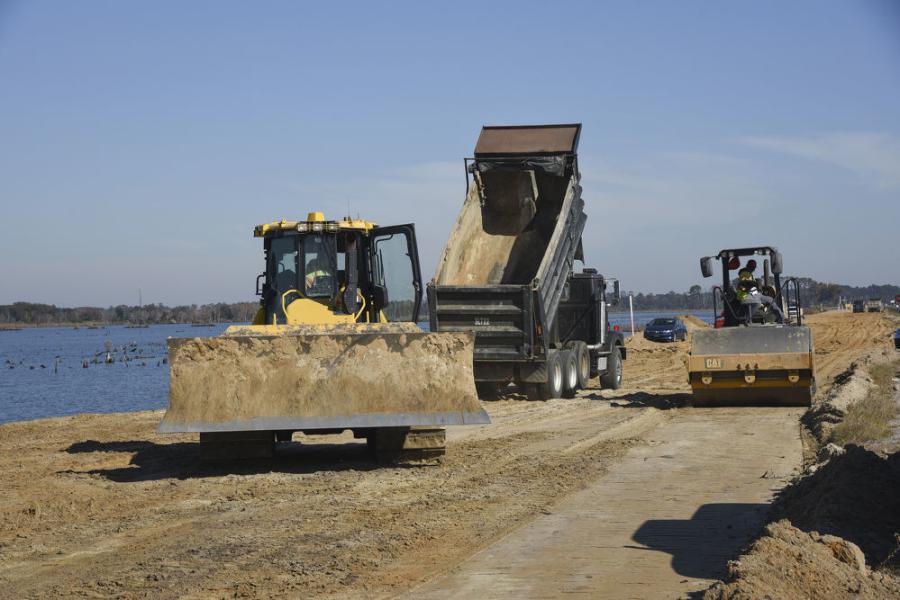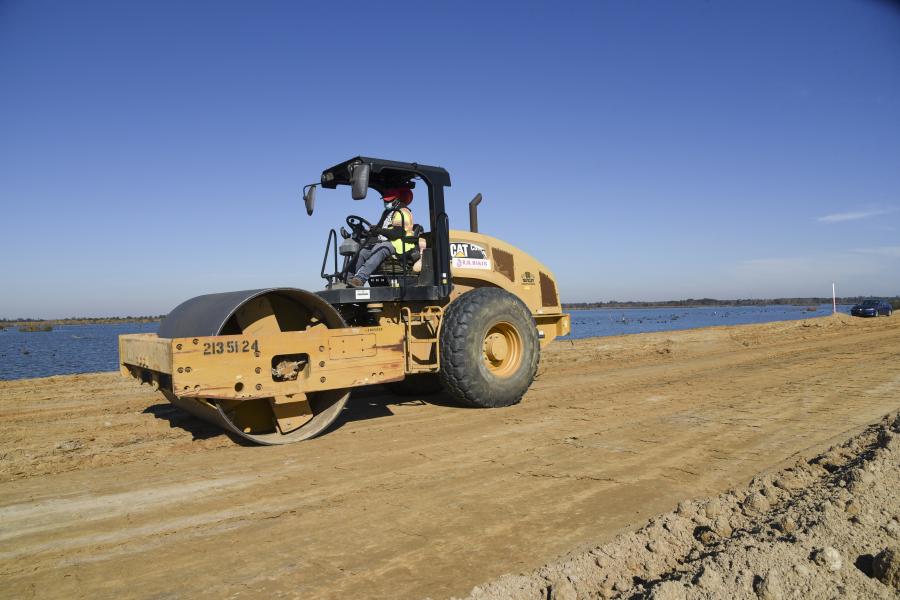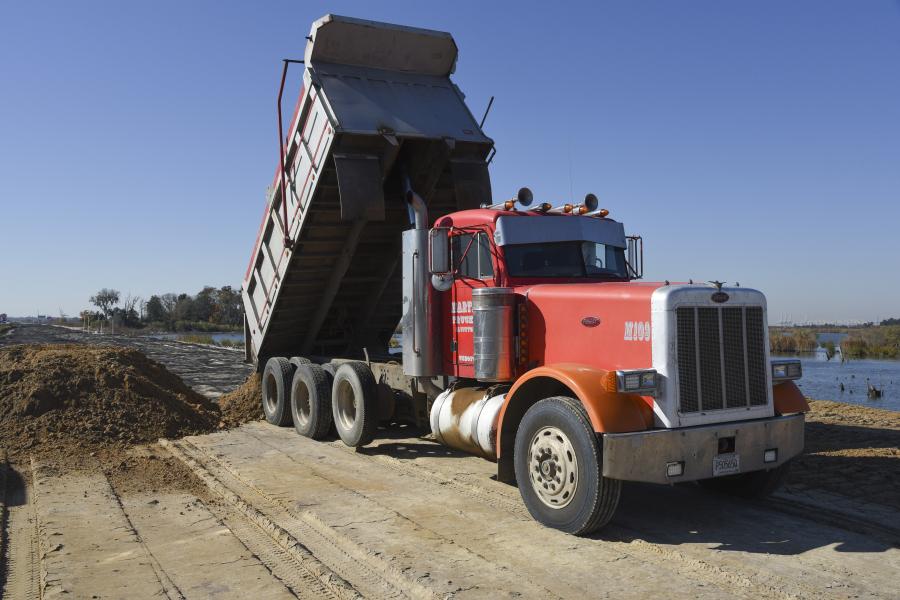Installation of the borrow material is carefully controlled by construction sequencing to prevent overloading the existing soils. Overloading of the existing soils could create mud waves into the surrounding marsh.
(SCDOT photo)
To enhance safety and accommodate increasing traffic associated with residential and economic growth in the region, the South Carolina Department of Transportation (SCDOT) is overseeing construction to widen nearly 4.2 mi. of U.S. 17 from the Georgia border to the intersection of SC 315 near Hardeeville. SCDOT will expand the roadway from two to four lanes and make improvements that include bike lanes, wider paved shoulders, turn lanes and a traffic signal at the intersection of U.S. 17 and SC 315.
"South Carolina is one of the fastest growing states in the country," said Pete Poore, SCDOT communications director. "Many new residents and businesses have been attracted to the state's coastal areas. The U.S. 17 project in Jasper County is a commuter route for South Carolina residents who work in the Savannah area.
"Widening this highway from two to four lanes also provides more efficient and safer highway infrastructure. SCDOT is pleased to have this project under construction, to allow Jasper County to share in the state's booming economic growth."
The U.S. 17 widening project is a part of SCDOT's 10-Year Plan to repave South Carolina's aging corridors; rebuild or replace deteriorating bridges; make rural roads safer; and improve key portions of interstates. The $41.9 million undertaking includes a divided grass median between the new four lanes, wider shoulders and safety rumble strips.
"The Highway 17 widening project accomplishes several goals," said J. Barnwell Fishburne, chairman of the SCDOT Commission representing the 6th Congressional District. "It updates the road infrastructure and improves the safety of our citizens as they travel the corridor. It also supports the region's growth and economic development efforts now and for the future. Better safety and quality and a stronger economy for South Carolinians are what SCDOT's mission is all about."
According to Greg Moore, SCDOT construction engineer of Beaufort and Jasper counties, the biggest challenge for crews is construction of the new roadway section in the marsh and wetland areas.
"These areas have poor soil stability, and the design engineers projected a considerable amount of settlement. Several measures are being utilized to overcome these challenges, including a granular bridge lift, high-strength geotextile fabric, geogrid reinforcement, prefabricated vertical drains, surcharge with settlement monitoring and detailed construction sequencing with settlement timelines throughout the phases of construction. In addition, the construction sequencing is intended to prevent impacting the wetland areas outside our permitted limits."
Workers are currently building the granular bridge lift; installing geogrid reinforcement; hauling and compacting the roadway embankment; installing settlement monitoring devices; and installing and maintaining erosion control devices for environmental permit compliance.
Ground improvements, including specialized work on new roadway embankments and compacting the soil to support the new highway, will add time to construction, with a completion date of late 2025. The project — considered a top road infrastructure priority for the region — is funded by SCDOT through the Lowcountry Area Transportation Study (LATS) and the Lowcountry Council of Governments.
Moore said tasks already completed include the full depth pavement rehabilitation on U.S. 17; the shifting of traffic into two 11-ft. wide lanes; and installation of the current phase prefabricated vertical drains.
Prep work has involved considerable coordination with utility companies and the relocation of necessary utilities. It's also included the installation of erosion control devices for environmental permit compliance. Survey control verification and preliminary staking also were essential in accurately laying out the new roadway and maintaining work within the permitted limits.
In expanding from two to four lanes, the staging and sequencing requires the construction of one half of the road, then shifting traffic onto the new two-lane portion.
"Once traffic has been shifted, the contractor can then begin construction on the second half of the road before opening it to four lanes of travel in its final condition," said Moore. "Other components of the expansion, aside from the pavement structure, include earthwork for the roadway embankment, new and extended drainage structures, asphalt paving, roadway signage and striping and signal installation. In addition, the maintenance of two-lane two-way traffic is a requirement throughout construction."
Moore noted that construction of a divided grass median between the new four lanes includes a sequence of activities that allows for this to be accomplished after traffic shifts to the initial new two- lane section. Once traffic has been shifted, the embankment construction and grading of the grass median can be performed, and the area will be permanently seeded for stability.
The project also calls for wider shoulders.
"The roadway will be constructed in its new location without widening the shoulders of the existing roadway, except where the widened section tapers back into the existing two-lane roadway."
The bike lanes will be 6 ft. wide and constructed on the outside shoulders of the northbound and southbound travel lanes. To produce the safety rumble strips, a small milling machine is used to cut into the asphalt at the specified intervals.
The intersection improvements at SC 315 will include signalization, a protected through lane along U.S. 17 heading southbound, turn lanes with additional storage, and also will maintain the dedicated right turn lane from U.S. 17 northbound to SC 315. The new traffic signal will include the installation of steel strain poles, new traffic signal heads and the installation of a control cabinet. The signal installation will be performed throughout the project and will require adjustment as the construction progresses.
As for excavation work, due to the existing topography of the project location, crews will be utilizing borrow material from offsite to construct the roadway widening.
"The quantities include more than 1,000,000 cubic yards of combined earthwork activities to complete this project," said Moore. "The earthwork quantity includes the granular bridge lift, borrow excavation and unclassified excavation. The installation of the borrow material is carefully controlled by construction sequencing to prevent overloading the existing soils. Overloading of the existing soils could create mud waves into the surrounding marsh."
The earthwork activities during construction cover more than 1,327,400 cu. yds. This includes unclassified excavation, borrow excavation, granular bridge lift and unclassified specials.
Key tasks remaining on the project include the completion of the initial two-lane widening section; earthwork and surcharge installation; settlement timeline of 12-18 months verified by settlement monitoring devices; removal of surcharge; installation and extension of drainage structures; fine grading; paving; and then shifting of traffic on this part. At that point, the entire second half of the roadway will be constructed.
Heavy equipment needed for the project includes D61 and D51 Komatsu low ground pressure bulldozers; an 85G John Deere excavator; a 624 John Deere wheel loader; a PC360 Komatsu excavator; a Caterpillar motor grader; Caterpillar rollers; a PVD tracked installation machine; and an E50 Wilson amphibious excavator.
Main materials include granular bridge lift, borrow, asphalt, drainage culverts and concrete for the culvert extensions.
The three primary concerns crews focus on while constructing projects of this magnitude include the safety of the workers and motoring public, environmental permit compliance and the quality of materials and workmanship.
As for the most time-consuming part of the construction, said Moore, "This will include the placement of borrow material and the required settlement durations as outlined in the sequencing."
RB Baker, a division of Reeves Construction Company, serves as the prime contractor.
"They have extensive experience in varying and complex projects," said Moore. "They have demonstrated a commitment to safety, environmental compliance and quality over the life of this project."
He added, "I appreciate the opportunity to serve SCDOT and take great pride in serving the public on this project of regional significance. The greatest reward comes from delivering projects like this to completion, but my daily reward is working with a team of committed partners working toward that goal." CEG
Today's top stories



























